

The Kingdom of Denmark (Danmark), a constitutional monarchy located at the mouth of the Baltic Sea, has an area of 16,639 sq. mi. (43,070 sq. km.) and a population of 5.2 million. Capital: Copenhagen. Most of the country is arable. Agriculture, is conducted by large farms served by cooperatives. The largest industries are food processing, iron and metal, and shipping. Machinery, meats (chiefly bacon), dairy products and chemicals are exported.
Denmark, a great power during the Viking period of the 9th-11th centuries, conducted raids on western Europe and England, and in the 11th century united England, Denmark and Norway under the rule of King Canute. Despite a struggle between the crown and the nobility (13th-14th centuries) which forced the King to grant a written constitution, Queen Margaret (Margrethe) (1387-1412) succeeded in uniting Denmark, Norway, Sweden, Finland and Greenland under the Danish crown, placing all of the Nordic countries under the rule of Denmark. An unwise alliance with Napoleon caused the loss of Norway to Sweden in 1814. In the following years a liberal movement was fostered, which succeeded in making Denmark a constitutional monarchy in 1849.
In addition to the handguns listed below, the Danes used the Browning Hi-Power 9mm pistol designated the Model 46. They also used the Swedish Model 40 Lahti, called the Model 40S by the Danes. In the late 1940s the Danes adopted the SIG 9mm Model 47/8 pistol (P-210-2).
Model 1871
This 6-shot revolver was built on a Lefaucheux-Francotte solid frame fixed cylinder with non-mechanical ejection. This is an 11mm pinfire revolver. Octagon barrel length is 5 inches. Weight is about 34 oz. Smooth wooden grips with lanyard loop. Built by the Belgian firm of Auguste Francotte. Issued to the Danish navy from 1871 to 1882.
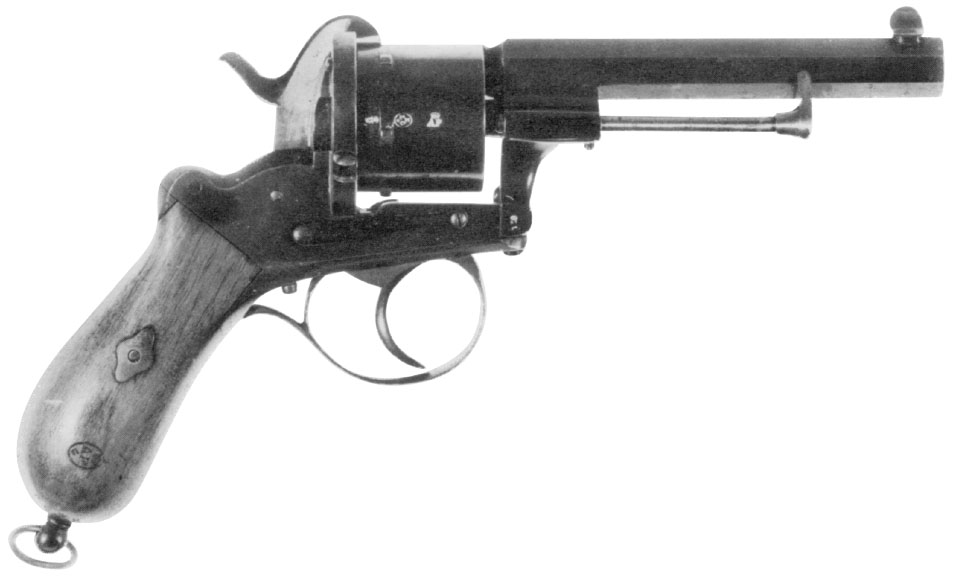
Courtesy Geschichte und Technik der europaischen Militarrevolver, Journal-Verlag Schwend GmbH with permission
Exc. |
V.G. |
Good |
Fair |
850 |
600 |
400 |
200 |

Courtesy Geschichte und Technik der europaischen Militarrevolver, Journal-Verlag Schwend GmbH with permission
Model 1871/81
This model is a Model 1871 converted to centerfire 11mm. The conversion was done at the Danish navy yard in Copenhagen in 1881. All other specifications are the same as those for the Model 1871.
Exc. |
V.G. |
Good |
Fair |
750 |
500 |
300 |
150 |
Model 1865/97
This revolver is built on the Chamelot-Delvigne solid-frame, fixed-cylinder action with non-mechanical ejection. It was originally issued to the Danish navy in 1865 as an 11mm pinfire sidearm and was later converted in Kronberg to 11.45mm centerfire revolver. The revolver is fitted with a lever-type safety that blocks the hammer from the cylinder when engaged. Barrel length is 5 inches. Checkered wood grips with lanyard loop located behind the hammer. Weight is about 30 oz. Issued to the Danish navy from 1897 to 1919.

Courtesy Geschichte und Technik der europaischen Militarrevolver, Journal-Verlag Schwend GmbH with permission
Exc. |
V.G. |
Good |
Fair |
1750 |
1000 |
600 |
350 |
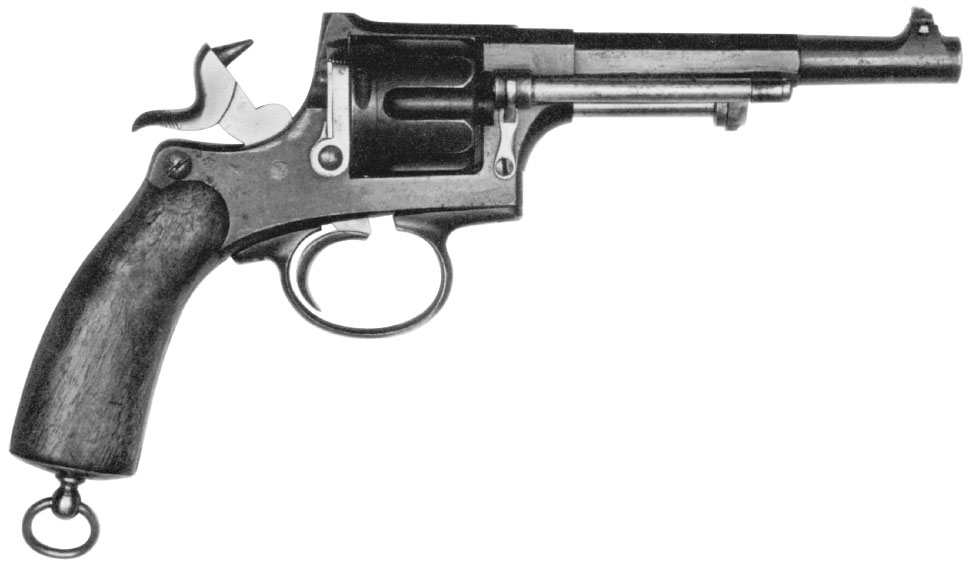
Courtesy Geschichte und Technik der europaischen Militarrevolver, Journal-Verlag Schwend GmbH with permission
Model 1882
This revolver was built on the Lefaucheux-Francotte solid-frame fixed cylinder with non-mechanical ejection. Capacity was 6 rounds and the gun was chambered for the 9mm cartridge. The half-round half-octagon barrel was 5.5 inches. This revolver was issued to Danish NCOs from 1888 to 1919.
Exc. |
V.G. |
Good |
Fair |
1200 |
650 |
400 |
200 |
Model 1886
This revolver was chambered for the 9.5mm cartridge and fitted with a 3-inch barrel. Built by Auguste Francotte in Liege, Belgium, and issued to military police units in the Danish army beginning in 1886.
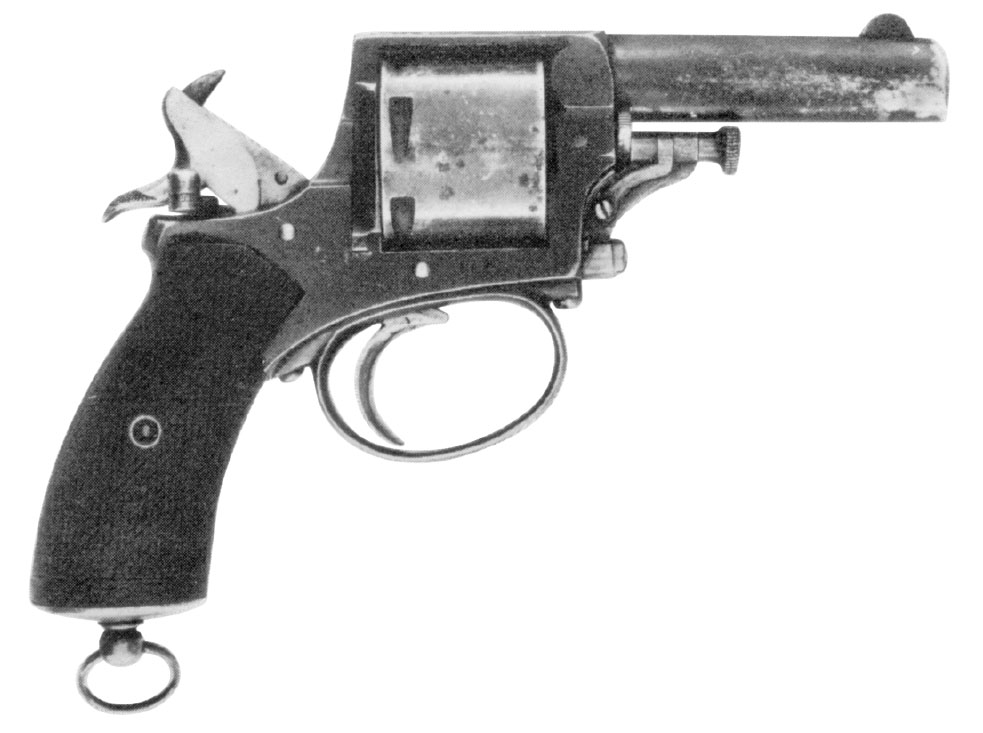
Courtesy Geschichte und Technik der europaischen Militarrevolver, Journal-Verlag Schwend GmbH with permission
Exc. |
V.G. |
Good |
Fair |
850 |
600 |
400 |
250 |
Model 1891
This revolver employed a top-break, hinged frame with latch and was chambered for the 9mm cartridge and fitted with a 6.3-inch half-round half-octagon barrel. Checkered wooden grips with lanyard loop. Built by J.B. Ronge fils of Liege, Belgium. Weight is about 33 oz. Issued to Danish navy units from 1891 to 1941.
NOTE: A training version of this revolver was also used by the Danish navy and was chambered for the 5.1mm cartridge. All other specifications are the same.
Standard Model
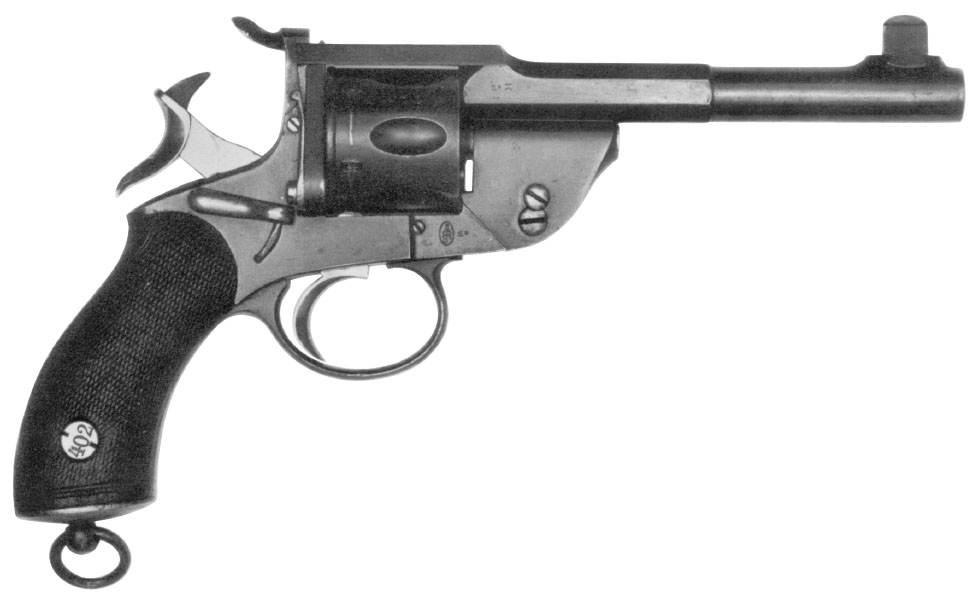
Courtesy Geschichte und Technik der europaischen Militarrevolver, Journal-Verlag Schwend GmbH with permission
Exc. |
V.G. |
Good |
Fair |
1200 |
650 |
400 |
250 |
Model 1891/96 Training Version

Courtesy Geschichte und Technik der europaischen Militarrevolver, Journal-Verlag Schwend GmbH with permission
Exc. |
V.G. |
Good |
Fair |
3500 |
1750 |
800 |
500 |
Bergmann-Bayard Model 1908
Built by the Belgium firm of Pieper SA from 1908 to about 1914. Caliber is 9×23mm Bergman-Bayard with 4-inch barrel. Many foreign contracts were built in this model.
Exc. |
V.G. |
Good |
Fair |
2000 |
1500 |
800 |
500 |
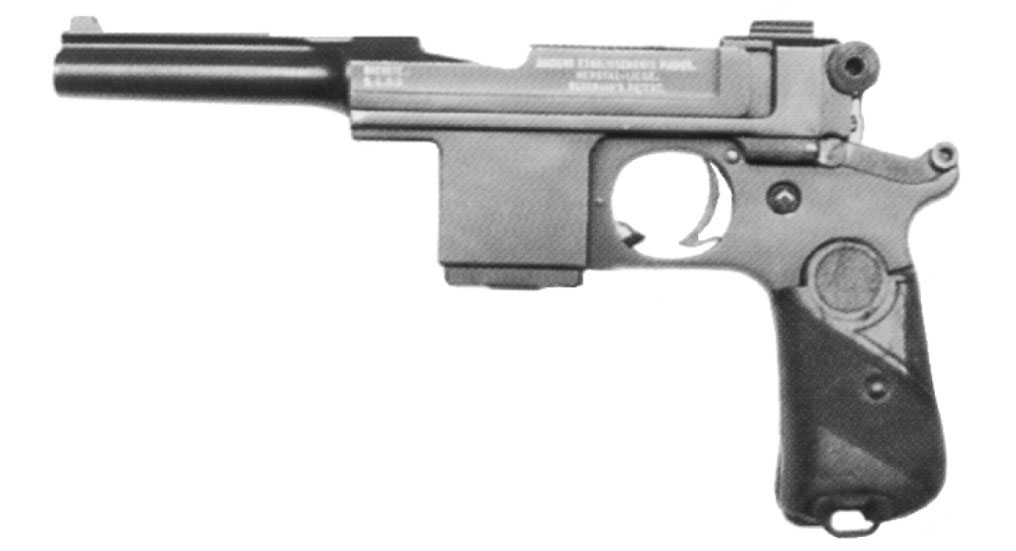
Courtesy Rock Island Auction Company
Bergmann-Bayard Model 1910-21
After WWI Pieper could no longer supply Bergmann-Bayard pistols to the Danish army, so Denmark made their own at their two national arsenals, Haerens Rustkammer and Haerens Tojus as the Model 1910-21. Most pre-war Pieper-made pistols were modified to 1910-21 configuration during the postwar years.

Courtesy Rock Island Auction Company
Exc. |
V.G. |
Good |
Fair |
1500 |
1100 |
850 |
700 |
Danish Holster for Bergman-Bayard Model 1910-21
Leather construction with carrying strap. Price range: 250 – 100.

Danish Holster for Bergman-Bayard Model
Model 46
This is the Danish designation for the postwar Browning Hi-Power. Marked “M 1946 HV” on the left side of the frame. Fixed sights.
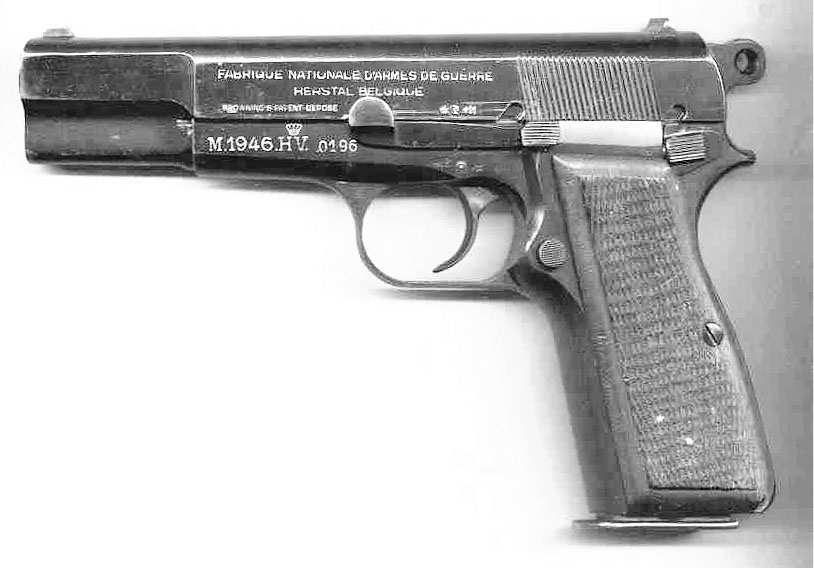

Exc. |
V.G. |
Good |
Fair |
1350 |
1100 |
950 |
650 |
P210 (Model 49)
See Switzerland, Handguns, SIG.
The Danish military has also used the Finnish Suomi MP41, the Swedish Model 37/39, and the HK MP5A2 and MP5A3 submachine guns.
Danish Hovea M49
Introduced in 1949 this submachine gun is chambered for the 9mm Parabellum cartridge and fitted with an 8.5-inch barrel. Folding metal butt. Magazine capacity is 35 rounds. Rate of fire is about 600 rounds per minute. Weight is approximately 7.5 lbs. This gun was originally developed by Husqvarna for the Swedish army. Denmark purchased the rights and built the gun for its own forces.

Courtesy private NFA collection
Pre-1968
Exc. |
V.G. |
Fair |
20000 |
18000 |
16000 |
Madsen M50
This submachine gun was produced from 1945 to 1953 by the Danes. It is chambered for the 9mm cartridge and is fitted with a 7.8-inch barrel. Its rate of fire is about 500 rounds per minute. Marked “MADSEN” on the right side of receiver. Weight is approximately 7 lbs.
This gun has some unusual features, such as a flat receiver with barrel attached with locking nut that when unscrewed allows the left side of the receiver to fold back to expose the right side, which contains all the moving parts. Fitted with a quick change barrel. Very simple design allows for fast and economical construction.

Courtesy private NFA collection
Pre-1968
Exc. |
V.G. |
Fair |
8000 |
7000 |
6000 |
Pre-1986 manufacture or re-weld
Exc. |
V.G. |
Fair |
5000 |
3500 |
3000 |
More recently, Danish military forces have used the U.S. M16A1 rifle, the HK G3, the M1 Garand, and the Enfield Model 1917 rifle.
Model 1867 Rifle
This rifle was modified from rimfire to centerfire. Chambered for the 11.7×42R Danish/Remington cartridge. Fitted with a 35.7-inch barrel. Weight is approximately 9.25 lbs. Full stocked with exposed muzzle and bayonet bar with lug on right side. Three barrel bands. On the left side of the receiver is marked “M.1867” with the Danish Crown. The upper tang is marked with either “REMINGTON” or “KJOBENHAVN” with the year of manufacture.

Bayonet for Remington Rolling Block
Exc. |
V.G. |
Good |
Fair |
750 |
625 |
450 |
350 |
Bayonet for Remington Rolling Block
Hard rubber grips. Muzzle ring. Hook quillon. 21.6-inch single edge yatagan-style blade. Steel tipped leather scabbard. Marked on ricasso “GEBR WEYERSBERG SOLINGEN.” Price range 250 – 125.
Model 1867 Carbine
Similar to the rifle but with half length walnut stock with one barrel band and 21-inch barrel. Three variations were produced: Artillery, Engineer, and Cavalry. Weight is approximately 7 lbs.
Exc. |
V.G. |
Good |
Fair |
850 |
700 |
550 |
400 |
Model 1867/93 Marine Rifle
This rifle was built in Denmark at Kjobenhavn Arsenal. It was essentially a Model 1867 rifle rebuilt to fire the 8×58R Danish Krag cartridge. Barrel length is 21 inches and weight is about 7 lbs. Nose cap has bayonet fittings.
Exc. |
V.G. |
Good |
Fair |
750 |
600 |
500 |
400 |
Model 1867/96 Cavalry Carbine
This model was also built in Denmark and was a Model 1867 carbine rechambered for the 11.7×51R Danish cartridge.
Exc. |
V.G. |
Good |
Fair |
750 |
625 |
500 |
375 |
The rifles listed below are war surplus captured from the Germans at the end of World War II. These rifles were converted by the Danes to military target rifles.
G98 Action Military Target Rifle (Model 52)
Exc. |
V.G. |
Good |
Fair |
750 |
500 |
350 |
250 |
K98k Action Military Target Rifle (Model 58)
Exc. |
V.G. |
Good |
Fair |
750 |
500 |
350 |
250 |
The Krag rifle was developed in Norway and first adopted by Denmark. It was standard issue in some form through WWII. For a list of U.S. models and prices see United States, Rifles, Krag Jorgensen. For those collectors who are interested in the Danish Krags, the only major difference, other than caliber, lies in the operation of the loading gate. Prices listed below are for unaltered Danish Krags. The forerunner of the U.S. Krags was the Model 1889 rifle.
NOTE: All Danish Krags are chambered for the 8×58Rmm cartridge.
Danish Model 1889
This rifle was developed by Ole Krag and Eric Jorgensen. It used a single forward bolt locking lug plus a bolt guide rib. Chambered for the 8×58Rmm cartridge, the rifle was fitted with a 33-inch barrel with full stock and no pistol grip. The barrel is fitted with a full-length metal handguard. A flush loose-loaded box magazine was used. The bolt handle was straight. There were a number of different carbine versions but all of these were full stocked and fitted with 23.5-inch barrel with bayonet lugs on all but one variation: the artillery carbine (see below). These guns are marked prior to 1910 “GEVAERFABRIKEN KJOBENHAVN” [date] over “M89” on the left side of the receiver. Approximately 140,000 of these rifles and carbines were manufactured prior to 1930. During the German occupation in WWII, the Germans reintroduced the rifle for its own use.
Exc. |
V.G. |
Good |
Fair |
1000 |
750 |
500 |
350 |
Bayonet for 1889 Krag rifle
Checkered hard rubber grips. 9.1-inch single edge blade. Steel tipped leather scabbard. Example shown is marked on ricasso “Alex Coppel Solingen.” Price range 175 – 100.

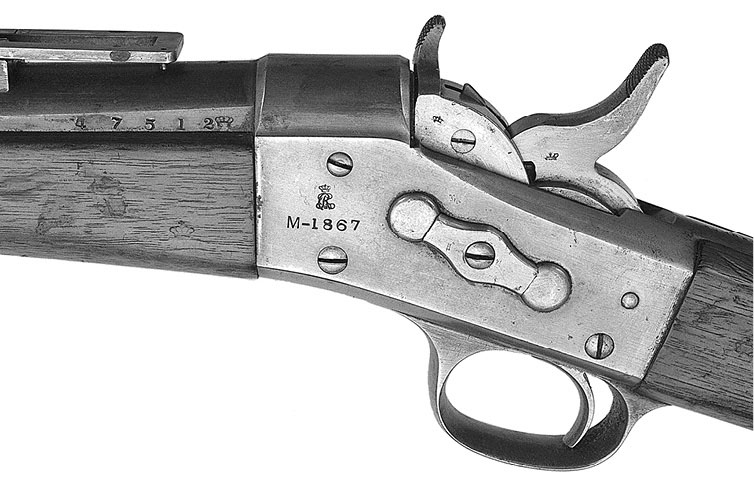
Model 1867 Rifle with loading indicator shown close-up • Courtesy Private collection, Paul Goodwin photo

Bayonet for 1889 Krag Rifle
Model 1889 Infantry Carbine
Introduced in 1924, this model is a converted Model 1889 rifle with metal barrel jacket and bayonet stud. Barrel length is 24 inches. Tangent rear sight. Magazine capacity is 5 rounds. Weight is about 8.5 lbs. Marked “F” before the serial number.
Exc. |
V.G. |
Good |
Fair |
1100 |
800 |
550 |
350 |
Model 1889 Artillery Carbine
Similar to the Infantry carbine and also introduced in 1924, this model features a turn down bolt handle, a triangle shaped upper sling swivel, and a hanger stud on the left side of the stock.
Exc. |
V.G. |
Good |
Fair |
1100 |
800 |
550 |
350 |
Model 1889 Engineer Carbine
This model was introduced in 1917. It is fitted with a wooden handguard and a slightly shorter barrel, about ½ inch. Marked with “I” before the serial number.
Exc. |
V.G. |
Good |
Fair |
1100 |
800 |
550 |
350 |
Model 1889 Cavalry Rifle
Introduced in 1914, this model is fitted for a bayonet. Straight bolt handle. Marked with “R” before the serial number.
Exc. |
V.G. |
Good |
Fair |
1100 |
800 |
550 |
350 |
Bayonet for 1889 Krag carbine
Wood grips. Muzzle ring. 17.6-inch single edge T-shaped blade. Steel tipped leather scabbard. Price range 175 – 100.


Danish Model 1889 Rifle • Courtesy West Point Museum, Paul Goodwin photo
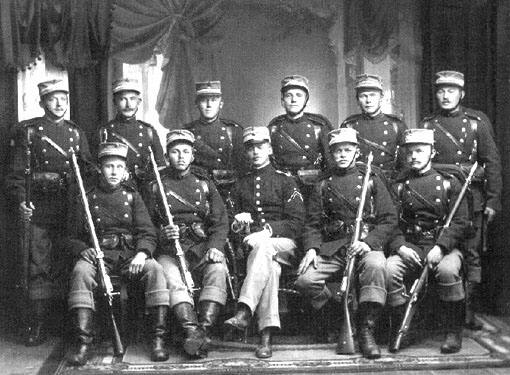
Danish troops with their Krags • Courtesy Paul S. Scarlata
Model 1928 Sniper Rifle
This model is based on the Model 1889 with half stock but fitted with a 26-inch heavy barrel, micrometer rear sight, and hooded front sight. Wooden handguard. Turned down bolt. Similar in appearance to the U.S. 30 caliber-style “T” rifle. Weight is approximately 11.5 lbs.
Exc. |
V.G. |
Good |
Fair |
1800 |
1200 |
800 |
500 |
Model 47
Sometimes referred to as the Madsen light military rifle, this post-WWII bolt-action rifle was sold to Colombia in limited quantities of 5,000 guns. Some rifles will have a metal disk on the left side bearing the seal of Columbia. These might bring $50-100 more. Fitted with a rubber buttplate. Chambered in .30-06. Other calibers were listed in the Madsen catalogue but the only order received was from Columbia. Barrel length was 23 inches with a magazine capacity of 5 rounds. Weight was about 8 lbs.
Exc. |
V.G. |
Good |
Fair |
750 |
600 |
450 |
325 |
NOTE: Add $150 for rifles with numbered matching bayonet.

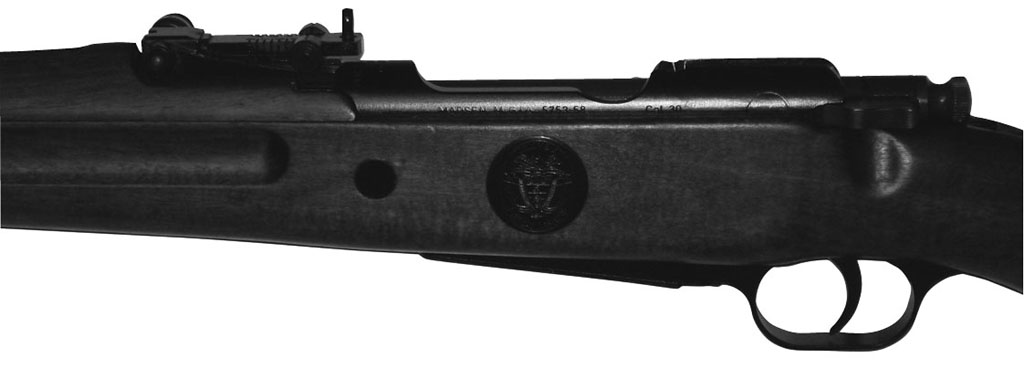
Madsen M1947, Columbian Armed Forces disk on left side

Bayonet for 1889 Krag Carbine

Bayonet for Madsen M 47
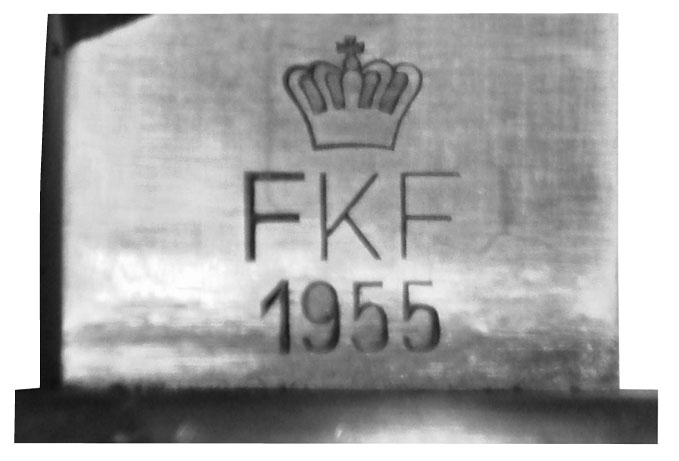
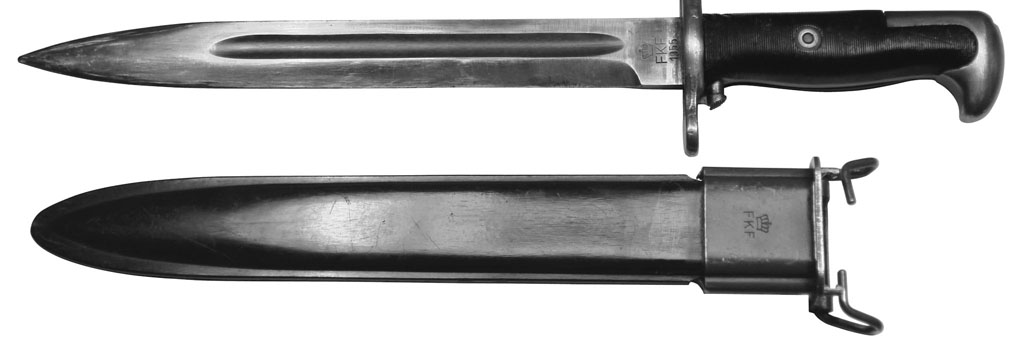
Bayonet for M-1 Garand
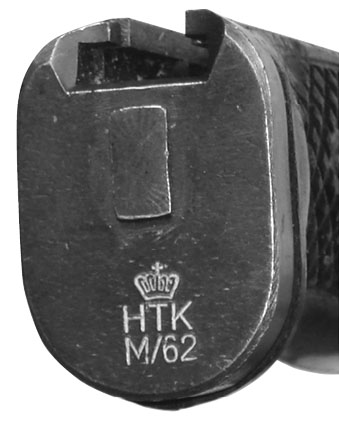
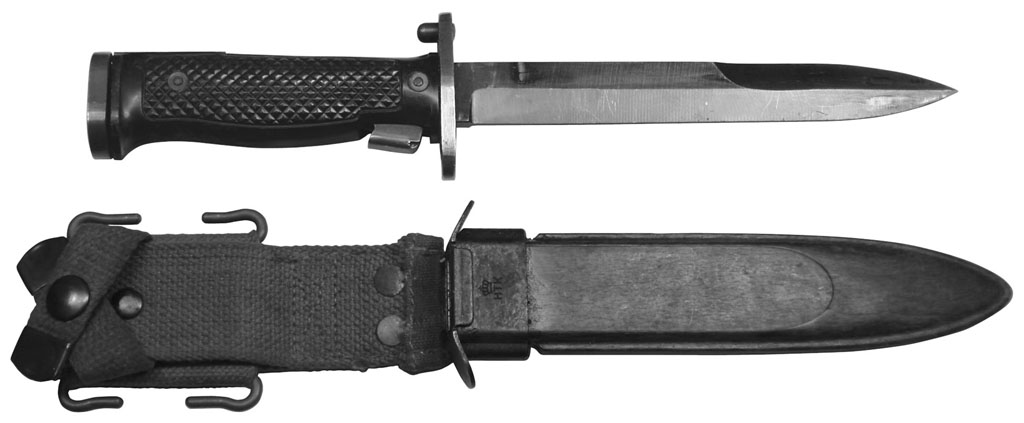
Bayonet for M-1 Garand
Bayonet for Madsen M 47
Wood handle. 8.25-inch inch double edge blade. Steel scabbard. The only marking is a serial number. Price range 150 – 70.
Bayonets for M-1 Garand
Denmark made their own M-1 and M-5 type bayonets for the M-1 Garand rifles they received from the U.S. The dimensions are the same as the U.S. versions. They have Danish markings. The scabbards are plastic and have a simulated wood appearance. Price range M-1: 125 – 60. Price range M-5: 100 – 50.
After WWII Denmark used the British Bren gun chambered for the .303 caliber, the Swedish Model 37 6.5mm gun, the U.S. Model 1919A4 and A5 versions, and the .50 M2 Browning. More recently the Danes used the German MG 42/59.
Madsen
This was the first practical light machine gun. It was produced from 1897 to 1955. It is chambered for several calibers from 6mm to 8mm. It is fitted with a 22.7-inch barrel and a top feeding 25-, 30-, or 40-round magazine. Rate of fire is 450 rounds per minute. Its weight is approximately 20 lbs. Marked “MADSEN MODEL” on the right side of the receiver. Found all over the world during a 50-year period.
Pre-1968
Exc. |
V.G. |
Fair |
12000 |
11000 |
10000 |


Chilean Madsen Model 1950 with receiver markings and crest • Paul Goodwin photo
Madsen-Satter
First produced in 1952, this belt-fed machine gun is chambered for the 7.62×51mm NATO cartridge. Designed to be used on a tripod for sustained fire, it had a rate of fire of 650 to 1000 rounds per minute (adjustable). Fitted with a 22-inch barrel. Weight is approximately 23.4 lbs. Marked “MADSEN-SETTER” on left front side of receiver. Many South American countries used this gun, as do many other countries around the world. Production stopped on this gun in 1960 in Denmark but continued under license to Indonesia until the 1970s.
Pre-1968 (Very Rare)
Exc. |
V.G. |
Fair |
25000 |
23000 |
22000 |
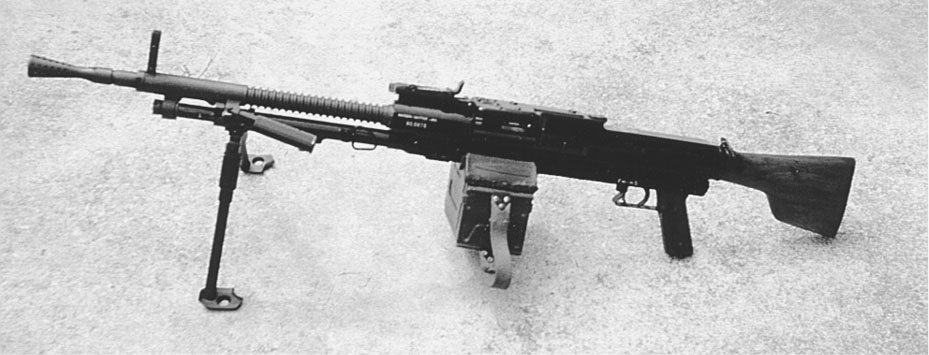
Courtesy private NFA collection